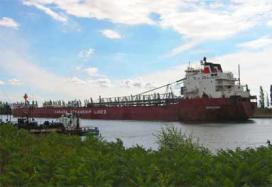Innovating through Technology at the Seaway: Even Old Infrastructure Dogs Can Learn New Tricks
"There is nothing quite like the Seaway," said Craig H. Middlebrook, Acting Administrator for the U.S. Saint Lawrence Seaway Development Corporation (SLSDC), speaking recently as part of Volpe's Straight from the Source transportation thought leadership lecture series.
In 1954, the United States joined Canada in the development of the St. Lawrence Seaway, a first-of-its-kind, deep draft, bi-national waterway. The Seaway system extends 3,700 km (2,340 miles) from the Atlantic Ocean to the head of the Great Lakes. Ranked as one of the outstanding engineering feats of the twentieth century, the Seaway includes 13 Canadian and 2 U.S. locks modeled on those built in the Panama Canal.
 Middlebrook discussed the tradition of innovation that flourishes at the Seaway, where leading-edge engineers and stakeholders respond to the many geographical and international challenges they encounter. He noted that SLSDC is able to stay small and responsive by collaborating with other organizations for the technical expertise they need; challenges only spur them forward. Three pioneering advances in vessel traffic management have resulted: Electronic Chart Display and Information System (ECDIS), Automatic Identification System (AIS), and Draft Information System (DIS).
Middlebrook discussed the tradition of innovation that flourishes at the Seaway, where leading-edge engineers and stakeholders respond to the many geographical and international challenges they encounter. He noted that SLSDC is able to stay small and responsive by collaborating with other organizations for the technical expertise they need; challenges only spur them forward. Three pioneering advances in vessel traffic management have resulted: Electronic Chart Display and Information System (ECDIS), Automatic Identification System (AIS), and Draft Information System (DIS).AIS is seen as the most important technological innovation in the Seaway's 53-year history. "It's hard to believe that what is now a ubiquitous technology was once groundbreaking and unique," says Middlebrook. Benefits include increased safety and reduced accidents.
"Volpe played a critical role in this project," he added, and named Volpe's own Mike Moroney, Kam Chin, and Dave Phinney as key contributors.
"The AIS project was a model partnership," said Middlebrook.
DIS was developed on the backbone of the AIS looking at what goes on beneath the surface with a 3-D interface. The DIS provides vessel operators with accurate data on river bottom contours and water levels along with the vessel's speed and heading. As a result, mariners will have a greater ability to implement effective course changes or other required reactions in transit.
Always ahead of the curve, the SLSDC continues to innovate in a world of emerging international standards, and succeeds. Middlebrook closed by offering key characteristics of an innovative organization, all of which lead to benefits simply by staying open to new ideas.
Photo above: Craig H. Middlebrook speaking. (Volpe photo)

